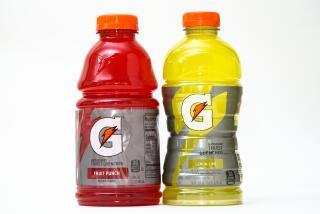Shrinking the Gadget, Not the Profit Margin
- Share via
The first law of consumer electronics is this: A gadget bought today will do more and sell for less tomorrow.
Few understand that better than Sin Hui Cheah.
“The consumer knows that if they wait, it will always be better and cheaper,” said Cheah, a concept engineer and product planning manager for Thomson, the French company that markets devices under the RCA nameplate. “It’s a curve we know and anticipate.”
As armies of engineers figure out how to squeeze more functions into ever smaller packages, companies, to prevent profit margins from shrinking too, are making sure more features are packed into higher-end, higher-margin devices.
“One of the big trends for multimedia gizmos is not just riding the cost curve down, but riding the performance curve up,” said Peter Glaskowsky, editor of Microprocessor Report in San Jose. “Companies are making devices that do a lot more. These capabilities then pull more money out of customers.”
Last year, for instance, the RCA Lyra digital music player was priced at $299 and stored 300 hours of music. This year, it stores twice as much music and weighs 27% less but sells for 10% more.
How did Thomson do it? Like others in the industry, it exploited global labor pools, falling commodity prices and technology advances. It also relied on old-fashioned ingenuity. Thomson’s efforts on the Lyra mirror the process that takes place at consumer electronics companies around the world.
One of the biggest changes was to the player’s disk drive, which stores digital music the same way a computer hard drive holds data. The Lyra’s drive looks the same as last year’s model. In fact, the raw materials and most of the components are the same.
But Thomson engineers in Hong Kong figured out how to cram twice as much data onto the same surface area. With the price of raw materials roughly the same, the cost per gigabyte is halved.
“The hard drive doubles in capacity every 12 to 18 months,” said Cheah, who designed the company’s first MP3 player. “Back in 1990, the state-of-the-art portable device stored 40 megabytes. Today, it’s 40 gigabytes.”
Two factors allow the drive to pack more data onto the same disk. The first is tinier components in the rectangular head that reads and writes data on the disk. The second is in the magnetic coating on the disk itself. “It’s a much finer grain of magnetic particles,” Cheah said.
Something that’s bigger, by 21%, is the liquid crystal display. Because of growing global demand for LCDs for everything from laptop computers to television sets, Chinese manufacturers have turned up the crank to boost production. As a result, Cheah said, LCD prices are dropping 10% to 20% a year -- making it economical to give the Lyra a bigger, brighter display screen.
The new LCD also features a blue light-emitting diode, or LED, backlight that costs less than the technology used in last year’s model.
The LED’s biggest advantage is that it drains 20% less power from the battery. The older version required 80 to 120 volts of power, which called for a separate semiconductor to convert and build up the power from the device’s 7-volt battery. The new LED display requires just 3 to 3.5 volts.
That change saved more than 50 cents per unit.
Using that and other savings, Thomson engineers included a more expensive lithium-ion polymer battery. The new battery takes less space and weighs less than the previous lithium-ion battery. Although less powerful than the older battery, the new power source provides the same 12 hours of playback because of reduced demands from the new LED.
Cheah said Thomson expected the price of lithium polymer batteries to drop at least 5% next year because of increased supplies to cellphone makers, a huge market that has helped grind down component costs. Basic economics plays a role: As supplies become more abundant, buyers are able to flex their muscles and demand discounts.
Another visible change is the case. The older model had a brushed aluminum case that had to be sandblasted. The new case is made of injection-molded plastic. Aside from cutting out the sandblasting step, the process also eliminated a set of metal brackets that held the disk drive to the case. Instead, the new drive snaps into holders molded into the plastic.
The switch helped shave weight as well as cost.
Finally, engineers dissected the player’s brains. The first unit had one semiconductor to handle all functions, a digital signal processor made by Texas Instruments Inc. The chip’s price fell significantly over the year, enough to let Thomson cover the cost of adding a second chip -- a microcontroller made by Cypress Semiconductor Corp.
The second chip is dedicated to controlling the transfer of songs from a computer to the player. The difference is significant -- a transfer of 1 gigabyte of data, about 250 songs, now takes about a minute, compared with 25 minutes in the older model.
Here, as with the fancier batteries, volume discounts drive down prices. When new chips come, not as many devices take advantage of them, so they are sold in smaller batches. Chip makers tend to charge more for brand-new technology to recoup big research and capital expenses.
As demand for the chips increases over time, chip makers spread the costs over larger volumes, lowering the unit price.
Similar changes ripple up and down Thomson’s product lines. On lower-end models, the savings are passed on to customers. On the Lyra, Thomson hopes the changes will persuade consumers to pay $29 more for this year’s model.
Analysts doubt it will be a difficult sell.
“It’s become fashionable to carry around these monster disks with your entire music collection,” said Omid Rahmat, publisher of Tom’s Hardware Guide in Thousand Oaks. “If you want to be the first on your block with one, you’re going to have to pay more.”





